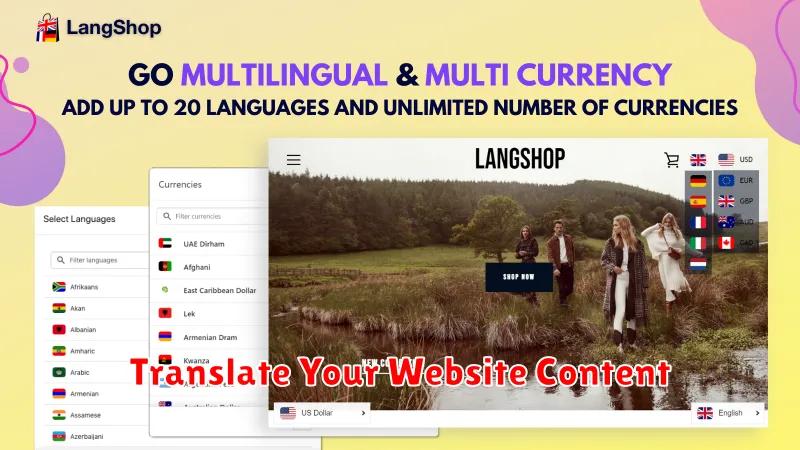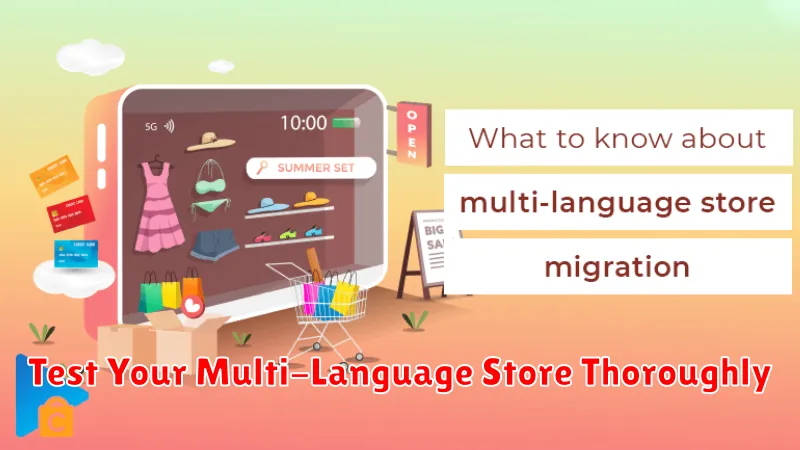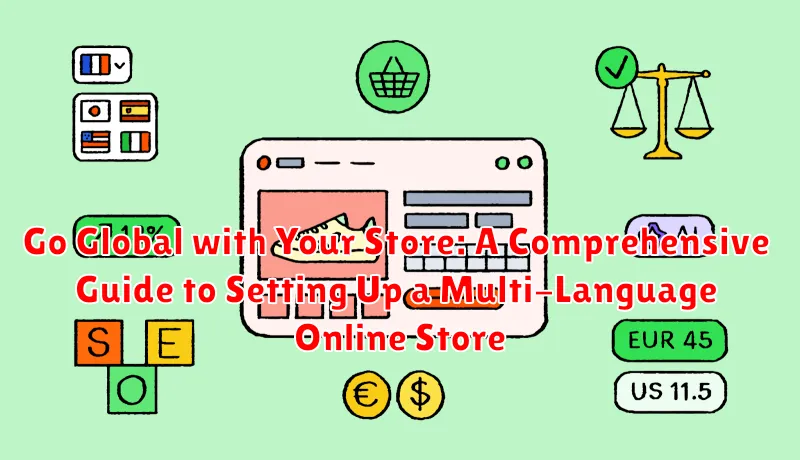In today’s interconnected world, expanding your business internationally is more crucial than ever. A multi-language online store can significantly broaden your reach, tapping into new customer bases and driving global growth. This comprehensive guide will provide you with the essential steps to effectively transform your online store into a multilingual platform, enabling you to connect with customers worldwide and unlock new international markets. Learn how to navigate the intricacies of localization, translation, and multi-currency support, ultimately setting the stage for international e-commerce success.
Taking your business global requires a strategic approach. From choosing the right e-commerce platform to understanding the nuances of different cultures, this guide addresses the key aspects of building a successful multi-language online store. We’ll cover everything from website translation and currency conversion to international shipping and customer service. Whether you’re a small business owner or part of a larger corporation, understanding the process of internationalization is paramount to achieving substantial global growth and maximizing your international e-commerce potential.
Choose a Platform that Supports Multiple Languages
Selecting the right e-commerce platform is crucial for building a successful multi-language online store. Your chosen platform should seamlessly integrate with multi-language functionalities, minimizing technical complexities and streamlining your workflow.
Look for platforms that offer built-in multi-language support or readily available integrations with reliable translation apps. These features allow you to manage translations efficiently, often directly within the platform’s interface.
Consider features like language switching options, allowing customers to easily select their preferred language. This improves user experience and encourages engagement. Also, assess the platform’s ability to handle different character sets and right-to-left languages to ensure proper display and functionality.
Researching different platforms and comparing their multi-language capabilities is essential. Factor in your budget, technical expertise, and the specific language requirements of your target markets. Choosing the right platform sets a strong foundation for your global expansion.
Translate Your Website Content

Accurate translation is crucial for a successful multi-language online store. Poor translations can damage your brand’s credibility and confuse customers. There are several approaches you can take to translate your content:
Professional Translation Services
Investing in professional translators ensures high-quality, accurate translations. They possess linguistic expertise and cultural understanding, minimizing the risk of misinterpretations. While this option is often more expensive, it yields the best results, particularly for technical or nuanced content.
Machine Translation
Machine translation tools offer a quick and cost-effective solution, especially for large volumes of content. However, the quality can vary significantly, and it’s essential to thoroughly review and edit machine-translated text to ensure accuracy and natural flow.
Community Translation
For some businesses, leveraging your community of users can be a viable option. This approach can be cost-effective and foster a sense of ownership among your customers. However, it’s important to implement quality control measures to ensure accuracy and consistency.
Implement Multi-Language SEO
Optimizing your multi-language online store for search engines is crucial for attracting international customers. Hreflang tags are essential for telling search engines which language each page is intended for, preventing duplicate content issues and ensuring the correct version appears in search results for each region. Accurately implementing hreflang tags is paramount for successful international SEO.
Keyword research should be conducted for each target language. Don’t simply translate your existing keywords; identify the terms your target audience in each region actually uses. These localized keywords should be integrated naturally within your website content.
Consider creating localized content beyond just translations. This could include blog posts, articles, or guides relevant to specific cultural contexts. This not only provides valuable information to your target audience but also enhances your website’s authority and relevance in local search results.
Finally, building local backlinks from reputable websites within your target regions can significantly boost your search engine rankings. These backlinks signal to search engines that your website is a trusted resource for that specific market.
Offer Multi-Currency Options
Allowing customers to shop in their local currency is crucial for a positive international shopping experience. Currency conversion can be a major deterrent for international buyers. Displaying prices in a familiar currency eliminates confusion and encourages purchases.
Integrating a multi-currency payment gateway is essential. This allows you to process transactions in various currencies and settle funds in your preferred base currency. Research different payment gateways to find one that supports the currencies you need and offers competitive transaction fees.
Dynamically updating currency exchange rates is also important. Fluctuations in currency values can impact your profit margins. Automate this process to ensure accurate pricing and avoid manual updates.
Clearly display the selected currency throughout the shopping experience. This reinforces trust and transparency with your customers. Consider using a currency switcher that allows customers to easily select their preferred currency.
Provide Multi-Lingual Customer Support
Offering support in your customers’ native languages is crucial for building trust and driving sales. Customers are more likely to purchase from a business that can address their questions and concerns in a language they understand.
Consider these options for providing multi-lingual support:
- Hire multi-lingual customer service representatives: This provides the most personalized experience and allows for real-time assistance.
- Use translation software for live chat: While not as nuanced as human interaction, translation software can provide adequate support for simple inquiries.
- Create a comprehensive multi-lingual FAQ section: Address common questions and concerns in various languages to reduce the need for direct contact.
- Offer email support in multiple languages: Ensure your team can respond to customer emails in their preferred language. Utilize translation services if necessary.
By offering multi-lingual customer support, you demonstrate a commitment to your international customers, fostering loyalty and encouraging repeat business.
Localize Your Marketing Efforts
Expanding your store internationally requires more than just translating your website. You need to localize your marketing efforts to effectively reach your target audience in each new market.
Begin by thoroughly researching your target market. Understand their preferred communication channels, cultural nuances, and online behavior. This will inform your marketing strategy and help you tailor your message for maximum impact.
Translate your marketing materials, including social media posts, email campaigns, and online advertisements. Don’t just translate literally – adapt the content to resonate with the local culture. Consider using local influencers or partnering with local businesses to enhance your reach and build trust.
Keywords are crucial. Perform keyword research specific to each region and language to optimize your website and marketing content for search engines. This ensures potential customers can find you easily.
Consider Cultural Differences
Expanding your business internationally requires more than just translating your website. Cultural nuances play a significant role in how customers perceive your brand and products. Overlooking these differences can lead to misinterpretations and missed opportunities.
Color symbolism varies across cultures. A color associated with positivity in one region might represent something negative in another. Similarly, imagery should be carefully chosen to avoid unintentional offense or miscommunication. What might be considered a harmless image in one culture could be inappropriate or even offensive elsewhere.
Payment methods are another crucial consideration. Preferred payment options differ significantly around the world. Offering familiar and trusted payment gateways for each target market is essential for building trust and encouraging conversions.
Customer service should also be culturally sensitive. Communication styles and expectations vary significantly. Providing support in local languages and understanding cultural norms for interaction will enhance customer satisfaction.
Test Your Multi-Language Store Thoroughly

Rigorous testing is crucial before launching your multi-language store. This ensures a seamless experience for customers in every target market.
Linguistic Testing: Verify the accuracy of all translated content, including product descriptions, navigation menus, and checkout processes. Consider employing native speakers for each language to catch nuances and ensure cultural sensitivity.
Functional Testing: Test all store functionalities in each language. This includes adding items to the cart, applying discounts, completing the checkout process, and managing user accounts. Ensure currency conversions and payment gateways function correctly for each region.
Usability Testing: Observe users navigating your store in different languages. Identify any points of confusion or frustration in the user experience. This can involve A/B testing different layouts or phrasing to optimize conversion rates.
Compatibility Testing: Ensure your website displays and functions correctly across different browsers, operating systems, and devices in all target markets.

